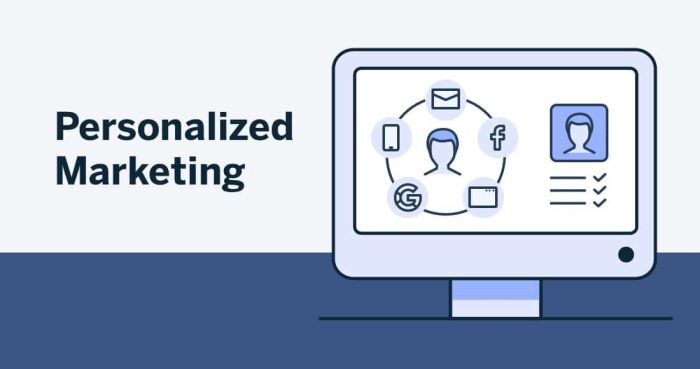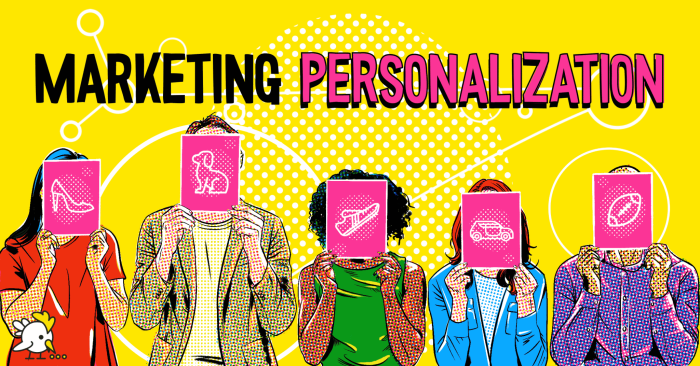Personalization in Marketing takes center stage as businesses strive to connect with customers on a deeper level, creating tailored experiences that resonate. Get ready to dive into the world of personalized marketing strategies that drive engagement and loyalty.
Definition of Personalization in Marketing
Personalization in marketing is all about tailoring your marketing efforts to meet the specific needs and preferences of individual customers. It involves using data and technology to create unique experiences for each customer, ultimately leading to higher customer satisfaction and loyalty.
Examples of Personalized Marketing Strategies, Personalization in Marketing
- Targeted Email Campaigns: Sending personalized emails based on past purchases or browsing behavior.
- Dynamic Website Content: Showing different content to users based on their preferences and behavior.
- Personalized Recommendations: Suggesting products or services based on a customer’s purchase history or interests.
The Importance of Personalization in Marketing
Personalization is crucial in marketing because it helps build stronger relationships with customers, increases engagement, and ultimately drives sales. By delivering relevant and timely messages to customers, businesses can create a more personalized and memorable experience, leading to higher customer satisfaction and loyalty.
Benefits of Personalization in Marketing

Personalization in marketing offers several key benefits that can significantly impact a company’s success. By tailoring marketing efforts to individual customers, businesses can enhance customer engagement, increase conversion rates, and foster customer loyalty.
Improved Customer Engagement
Personalization allows companies to create more targeted and relevant marketing campaigns, leading to higher engagement levels among customers. By delivering personalized content, recommendations, and offers, businesses can capture the attention of their audience and drive interaction with their brand.
Increased Conversion Rates
One of the major advantages of personalization in marketing is its ability to boost conversion rates. When customers receive personalized messages that resonate with their needs and preferences, they are more likely to make a purchase or take a desired action. This targeted approach can lead to higher conversion rates and ultimately drive revenue growth.
Enhanced Customer Loyalty
Personalization plays a crucial role in building long-term relationships with customers and fostering loyalty. By showing that they understand and care about individual customers, businesses can create a sense of connection and trust. This personalized experience can lead to repeat purchases, positive word-of-mouth referrals, and a loyal customer base that continues to support the brand.
Types of Personalization Techniques: Personalization In Marketing

Personalization in marketing can take various forms to cater to the unique preferences and behaviors of consumers. Here are some common types of personalization techniques used in marketing:
Dynamic Content Personalization
Dynamic content personalization involves tailoring website content based on user behavior, demographics, or past interactions. This technique allows marketers to display different content to different users dynamically, creating a more personalized experience.
Product Recommendations
Product recommendations utilize algorithms to suggest products or services to customers based on their browsing history, purchase behavior, or preferences. By analyzing user data, marketers can provide relevant suggestions that align with the individual’s interests, increasing the likelihood of a purchase.
Personalized Email Marketing Campaigns
Personalized email marketing campaigns involve sending customized emails to subscribers based on their preferences, purchase history, or engagement with previous emails. By addressing recipients by name, tailoring content to their interests, and sending targeted offers, marketers can enhance engagement and drive conversions.
Implementing Personalization in Marketing
To successfully implement personalization in marketing, businesses need to follow a strategic approach that involves collecting and utilizing customer data effectively. By personalizing marketing strategies, companies can enhance customer engagement, improve brand loyalty, and drive sales. Below are some steps, best practices, and challenges to consider when implementing personalization in marketing.
Steps to Implement Personalization in Marketing
- Identify Your Target Audience: Start by understanding your target audience’s preferences, behaviors, and demographics.
- Collect Customer Data: Utilize various data collection methods such as surveys, website analytics, and customer feedback to gather relevant information.
- Analyze Customer Data: Use data analysis tools to segment your audience based on common traits and preferences.
- Create Personalized Content: Develop customized marketing materials, product recommendations, and promotions tailored to each customer segment.
- Implement Automation: Utilize marketing automation tools to deliver personalized messages at the right time through the right channels.
Best Practices for Collecting and Utilizing Customer Data
- Obtain Consent: Ensure compliance with data privacy regulations by obtaining explicit consent from customers before collecting and using their data.
- Centralize Data Sources: Integrate data from various touchpoints such as social media, email, and website interactions to create a comprehensive customer profile.
- Use Predictive Analytics: Leverage predictive analytics to anticipate customer needs and personalize marketing efforts proactively.
- Test and Optimize: Continuously test different personalization strategies to identify what resonates best with your audience and optimize accordingly.
Challenges in Implementing Personalization and How to Overcome Them
- Data Security Concerns: Address customer concerns about data privacy by implementing robust security measures and transparent data handling practices.
- Data Silos: Break down data silos within the organization by integrating systems and ensuring seamless data flow between departments.
- Resource Constraints: Allocate sufficient resources in terms of budget, technology, and skilled personnel to effectively implement personalization strategies.
- Overpersonalization: Avoid overwhelming customers with excessive personalization by striking a balance between relevance and intrusion.
